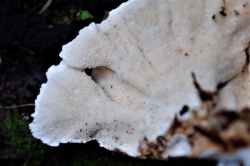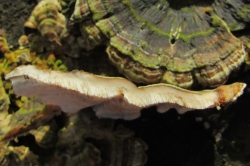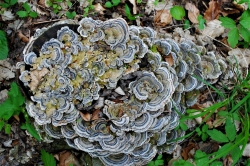A small size bracket fungus with multicoloured, zonated, faintly hairy skin and white pore surface.
Home / Mushroom Guide /
Turkey Tail
Turkey Tail
| Mushroom Type | |
| Common Names | Turkey Tail (EN), Cynffon Twrci (CY), Wrośniak Różnobarwny (PL), Lepketapló (HU) |
| Scientific Name | Trametes versicolor |
| Season Start | All |
| Season End | All |
| Average Mushroom height (CM) | |
| Average Cap width (CM) |
Fruiting Body
2–8(10) cm across, fan-shaped, irregularly semicircular, or even rosette-like, usually in groups. Margin mostly white, off-white or buff. Its skin is faintly hairy (tomentose), velvety, often shiny when young, with concentric multicoloured zones, or covered by algae with age.
Habitat
On dead hardwood logs, trunks and fallen branches, rarely on conifers too, in rows or tiers. Saprotrophic, causes white-rot.
Possible Confusion
Smoky bracket (Bjerkandera adusta), pictured, has a greyish pore surface.
Ochre bracket (Trametes ochracea) has less colour on its cap and different brown colours are the dominant, mostly found on Birch, but rather common on Beech and Poplar too, however it is a much less common mushroom.
Hairy curtain crust (Stereum hirsutum) has no visible pores at all, its underneath is smooth and yellow, while false turkey tail (Stereum ostrea) has smooth, reddish brown to reddish buff underneath, and its cap is less hairy (tomentose) than hairy curtain crust’s.
Spore Print
Spore print is white. Spores are colourless (hyalin), narrow-cylindric (sausage-like) and smooth.
Taste / Smell
Inedible, without distinct taste or smell.
Frequency
Very common and widespread.
Other Facts
In Southeast Asian countries turkey tail (Trametes versicolor) had been used to make decoctions for various health issues since 2nd century BC. If you want to make a tea of it, make sure that your ID is correct, also, be aware that it should be cooked for at least 30 minutes. Please don’t forget, if you have any health issues, consult to a qualified health professional before start self medicating!



 (86 votes, average: 3.67 out of 5)
(86 votes, average: 3.67 out of 5)


























Leave a Reply